
Altamura is a town and comune of Apulia, in southern Italy. It is located on one of the hills of the Murge plateau in the Metropolitan City of Bari, 45 kilometres southwest of Bari, close to the border with Basilicata. As of 2017, its population amounts to 70,595 inhabitants.
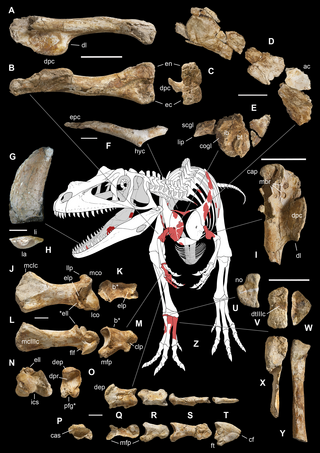
Saltriovenator is a genus of ceratosaurian dinosaur that lived during the Sinemurian stage of the Early Jurassic in what is now Italy. The type and only species is Saltriovenator zanellai; in the past, the species had been known under the informal name "saltriosaur". Although a full skeleton has not yet been discovered, Saltriovenator is thought to have been a large, bipedal carnivore similar to Ceratosaurus.

A fossil track or ichnite is a fossilized footprint. This is a type of trace fossil. A fossil trackway is a sequence of fossil tracks left by a single organism. Over the years, many ichnites have been found, around the world, giving important clues about the behaviour of the animals that made them. For instance, multiple ichnites of a single species, close together, suggest 'herd' or 'pack' behaviour of that species.

Brugherio is a comune (municipality) in the Province of Monza and Brianza in the Italian region Lombardy, located about 10 kilometres northeast of Milan. It was established December 9, 1866 unifying the suppressed municipalities of Baraggia, San Damiano and Moncucco, together with the villages of Bindellera, Cesena, Gelosa, San Paolo, Torazza, Occhiate and Increa.
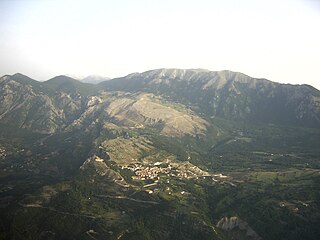
Pietraroja is a mountain comune (municipality) in the province of Benevento in Campania, southern Italy. It is approximately 50 km by car from Benevento, in direction north-west, 83 km from Naples in direction north-east and approximately 223 km from Rome in direction south-east.
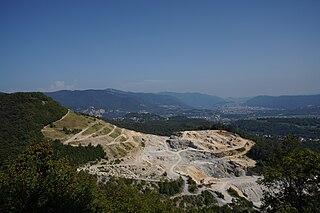
The Saltrio Formation is a geological formation in Italy. It dates back to the Early Sinemurian, and would have represented a pelagic or near-epicontinental environment, judging by the presence of marine fauna such as the nautiloid Cenoceras. The Fossils of the Formation were described on the late 1880s and revised on 1960s, finding first marine biota, such as Crinoids, Bivalves and other fauna related to Epicontinental basin deposits.

Dinosaur Ridge is a segment of the Dakota Hogback in the Morrison Fossil Area National Natural Landmark located in Jefferson County, Colorado, near the town of Morrison and just west of Denver.
The Calcare di Altamura is a Coniacian to early Campanian geologic formation in Italy. The formation comprises limestones that are highly fractured, in places karstified and dolomitized. Fossil ankylosaur tracks have been reported from the formation.
The Montemarcello Formation is a Late Triassic (Carnian) geologic formation in Liguria, Italy. Fossil prosauropod tracks have been reported from the formation.
The San Giovanni Rotondo Formation is an Early Cretaceous geologic formation in Italy. Fossil ornithopod tracks have been reported from the formation.
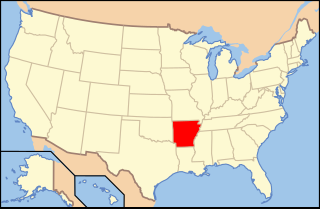
Paleontology in Arkansas refers to paleontological research occurring within or conducted by people from the U.S. state of Arkansas. The fossil record of Arkansas spans from the Ordovician to the Eocene. Nearly all of the state's fossils have come from ancient invertebrate life. During the early Paleozoic, much of Arkansas was covered by seawater. This sea would come to be home to creatures including Archimedes, brachiopods, and conodonts. This sea would begin its withdrawal during the Carboniferous, and by the Permian the entire state was dry land. Terrestrial conditions continued into the Triassic, but during the Jurassic, another sea encroached into the state's southern half. During the Cretaceous the state was still covered by seawater and home to marine invertebrates such as Belemnitella. On land the state was home to long necked sauropod dinosaurs, who left behind footprints and ostrich dinosaurs such as Arkansaurus.

Paleontology in Wyoming includes research into the prehistoric life of the U.S. state of Wyoming as well as investigations conducted by Wyomingite researchers and institutions into ancient life occurring elsewhere.

Paleontology in Utah refers to paleontological research occurring within or conducted by people from the U.S. state of Utah. Utah has a rich fossil record spanning almost all of the geologic column. During the Precambrian, the area of northeastern Utah now occupied by the Uinta Mountains was a shallow sea which was home to simple microorganisms. During the early Paleozoic Utah was still largely covered in seawater. The state's Paleozoic seas would come to be home to creatures like brachiopods, fishes, and trilobites. During the Permian the state came to resemble the Sahara desert and was home to amphibians, early relatives of mammals, and reptiles. During the Triassic about half of the state was covered by a sea home to creatures like the cephalopod Meekoceras, while dinosaurs whose footprints would later fossilize roamed the forests on land. Sand dunes returned during the Early Jurassic. During the Cretaceous the state was covered by the sea for the last time. The sea gave way to a complex of lakes during the Cenozoic era. Later, these lakes dissipated and the state was home to short-faced bears, bison, musk oxen, saber teeth, and giant ground sloths. Local Native Americans devised myths to explain fossils. Formally trained scientists have been aware of local fossils since at least the late 19th century. Major local finds include the bonebeds of Dinosaur National Monument. The Jurassic dinosaur Allosaurus fragilis is the Utah state fossil.
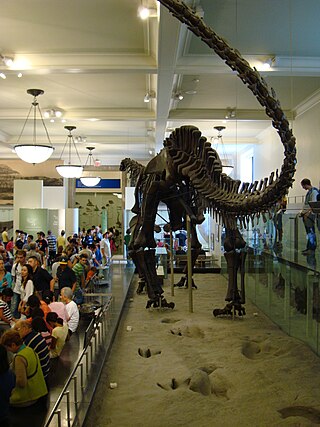
The 20th century in ichnology refers to advances made between the years 1900 and 1999 in the scientific study of trace fossils, the preserved record of the behavior and physiological processes of ancient life forms, especially fossil footprints. Significant fossil trackway discoveries began almost immediately after the start of the 20th century with the 1900 discovery at Ipolytarnoc, Hungary of a wide variety of bird and mammal footprints left behind during the early Miocene. Not long after, fossil Iguanodon footprints were discovered in Sussex, England, a discovery that probably served as the inspiration for Sir Arthur Conan Doyle's The Lost World.

Castelluccio culture is an archaeological feature dating to Ancient Bronze Age of the prehistoric civilization of Sicily, originally identified by Paolo Orsi on the basis of a particular ceramic style, in the homonymous village, between Noto and Siracusa.

The Increa Park is a green area in communal ownership in the south-west part of Brugherio, in Lombardy. Inside the Italian park is a large lake and the remains of the Increa Quarry, which gives its name to the park. This park is part of a larger national park called Parco Est delle Cave. It borders Cernusco sul Naviglio and it is near Milan's eastern bypass road. It covers about 33 hectares.

Cascina Increa is one of the farmhouses of Brugherio, on the southeastern border of the municipality. It enjoys the protection of the Soprintendenze per i Beni Architettonici e Paesaggistici, i.e., the Ministry of Cultural Heritage and Activities and Tourism (MiBACT) of its respective province because of its surviving Renaissance architecture.

The Rotzo Formation is a geological formation in Italy, dating to roughly between 192 and 186 million years ago and covering the Pliensbachian stage of the Jurassic Period in the Mesozoic Era. Has been traditionally classified as a Sinemurian-Pliensbachian Formation, but a large and detailed dataset of isotopic 13C and 87Sr/86Sr data, estimated the Rotzo Formation to span only over the Early Pliensbachian, bracketed between the Jamesoni-Davoei biozones, marked in the Loppio Oolitic Limestone–Rotzo Fm contact by a carbon isotope excursion onset similar to the Sinemu-Pliens boundary event, while the other sequences fit with the a warm phase that lasts until the Davoei biozone. The Rotzo Formation represented the Carbonate Platform, being located over the Trento Platform and surrounded by the Massone Oolite, the Fanes Piccola Encrinite, the Lombadian Basin Medolo Group and Belluno Basin Soverzene Formation, and finally towards the south, deep water deposits of the Adriatic Basin. The also Pliensbachian Aganane Formation of Morocco represents a regional equivalent, both in deposition and faunal content.
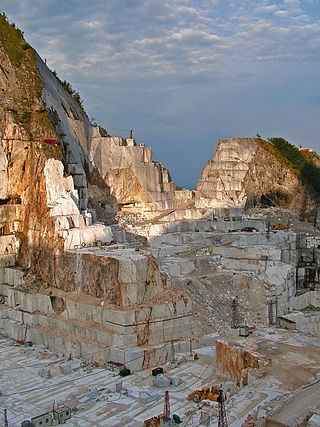
No Cav is an Italian protest movement that arose in the early 21st century, criticising the Carrara marble quarries in the Apuan Alps.

Tridentinosaurus is a dubious genus of extinct fossil reptile from the early Permian Regnana Formation of the Italian Alps. The genus contains a single species, T. antiquus. Tridentinosaurus represents one of the oldest known vertebrate fossils found in Italy. The only parts of the skeleton that are preserved are the long bones of the hind limbs, and the supposed soft tissue body outline is a forgery done with paint, though some genuine scales may also be preserved. Due to the poor preservation of the limb bones, the validity of the taxon is questionable.

















